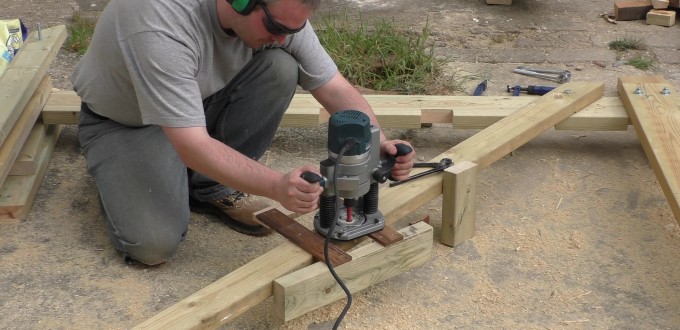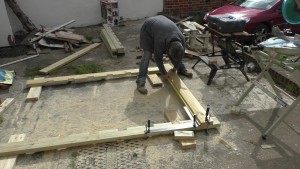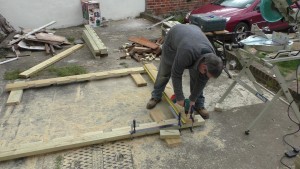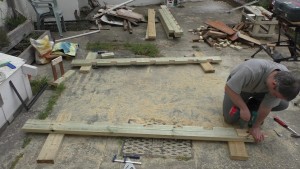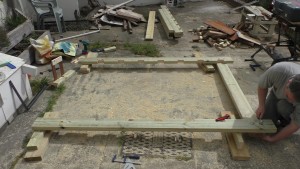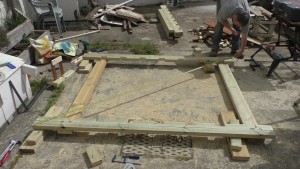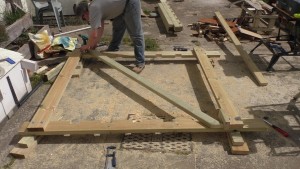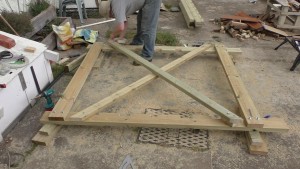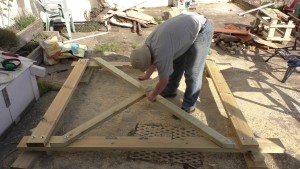In part three I prepared the legs, made some jigs and cut the rung sockets. In this part I will attach the stretchers and cross bracing thus completing one side.
Attach the Stretchers
The next step is one that requires patience as you have to fit the stretchers. How well you do this determines how square your scaffold will be at the end so take some time. Lay two legs down, propping them up on some scraps to make clamping easier, and then lay the stretchers on top. Make sure that the rung sockets face in since this is the final arrangement of the scaffold.
Using a large framing square clamped to one of the legs square up the stretcher relative to the leg. I found using a piece of box section steel also help but it’s not entirely necessary. I strongly suggest checking your framing square for squareness before starting as I found mine as nearly a degree out.
Once you are happy that the stretcher is square at one end drill through the stretcher and the leg (the stretcher should already have holes) and then insert bolts (but not nuts) to hold the completed corner square.
Congratulations, the most difficult part is now complete. Repeat the process for the remaining three corners and then take it all apart and turn it over.
The working platform is designed to slide inside the legs with a few millimetres of clearance on each side and because of this the bolt heads need to be countersunk into the leg on the inside. Using the jig made above counterbore each bolt hole.
Push bolts back through the holes this time making sure to include washers. Using a spanner and a socket wrench tighten up the fixing. These parts wont be coming apart on a regular basis so make them good and tight.
Once all four corners are done measure the corner to corner or distance of each diagonal. If the frame is out of square it will show as a difference in the two measurements and you need to tap on the longer diagonal with a mallet until the measurement is the same as the smaller diagonal. In my case the difference was just 2mm which is amazing on a frame of this size.
Attach the Cross Bracing
Although the frame is currently square it won’t stay square unless it is braced. The bolts holding it together now may seem like they are holding it firm but over time the frame would wrack if left like this. Unfortunately the cross bracing that will be fitted next goes on the outside fact of the leg which means the frame needs to be carefully turned over. It’s worth measuring it for square after it’s been moved but it should be able to handle this level of movement.
Lay a piece of bracing timber diagonally on the legs, mark where it overhangs the leg and cut it off with the jigsaw. In my case the angle the brace end was cut at was 51 degrees but it will vary depending on the size of your scaffold. I used a couple of scraps to keep the bracing away from the stretchers but this was just for looks. As long as your bracing runs roughly from corner to corner it doesn’t matter exactly where it goes.
Layout for a bolt to hold the bracing in place and then drill it at 10mm diameter both ends. Remove the first piece of bracing and then repeat the process for the other diagonal. You may have noticed now that the two bracing pieces won’t both fit on the frame at the same time. In order to fix this it’s necessary to cut a half lap joint in the middle of both pieces.
Fit one brace and then lay the other over the top and using a couple of extra long 10mm bolts pin the top piece into place. It’s then a simple matter of marking exactly where the two pieces need to be socketed.
With the bracing marked up for the half lap joint it’s simply a matter of routing out the socket which can be done using the same jig as was using for the rungs. Note that the jig will have to secured at an awkward angle in order to cut this joint. Rather than try to customize the jig I simply nailed it to the bracing.
Finally lay the two pieces of bracing on the legs and fit them together. I found I had a slight bow in one piece of bracing stock so it tool a little persuasion to go home. Once it was home I secured the joint with a screw.
As with the bolt holes for the stretchers the bolt heads will need counterboring for the bracing. This can be done one at a time once the piece is turned over again.
With one side complete it’s time to make the other, I’m tired just thinking about it. In part five I assemble the tower.
